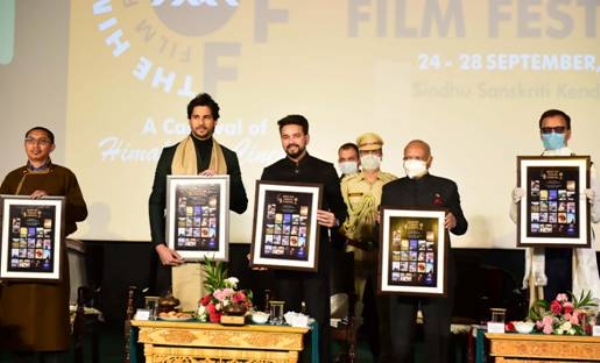Ladakh hosts first Himalayan Film Festival; Shershaah screened on opening ceremony
The five-day Himalayan Film festival is being held from September 24-28 as a part of the Azadi Ka Amrit Mahotsav celebrations.
Total Views |
Ladakh, Sept 25: Ladakh on Friday hosted the first-ever Himalayan Film Festival, which was inaugurated by Union Information and Broadcasting Minister Anurag Thakur. The five-day festival is being held from September 24-28 as a part of the Azadi Ka Amrit Mahotsav celebrations. Apart from that, Sidharth Malhotra attended the screening of Shershaah at the festival.
Shershaah, a film on late Captain Vikram Batra, was shown on the big screen for the first time during the opening session of the festival in the presence of actor Sidharth Malhotra and his co-actors, director Vishnu Vardhan and film personalities such as Vidhu Vinod Chopra and film critic Anupama Chopra.

The film festival, showcasing films from 12 Himalayan states and Union Territories to provide a platform to filmmakers, is being organised by the administration of Union Territory of Ladakh in collaboration with the Directorate of Film Festivals, Ministry of Information and Broadcasting. According to the reports, the film festival is being hosted in collaboration with the Ladakh Autonomous Hill Development Council, Leh.
Speaking during the event, Thakur termed cinema as one of the effective mediums to foster cultural diversity. He also announced that the transmission of Doordarshan (DD) Kendra-Leh’s programs would be extended to one hour from half an hour from October 1. Thakur said, "Would enhance the outreach of All India Radio and DD in the region and provide platform to young local talents." He also spoke on the emergence of OTT as a popular entertainment platform for the people during the COVID-19 pandemic. Quality content will ensure traffic and India has the potential to become the sub-continent of content creation, he added.
Also Read: Anurag Thakur to inaugurate five day Himalayan Film Festival at Leh on September 24
Thakur assured that the demand for collaboration between Ladakh and the Film and Television Institute of India (FTII) would be fulfilled at the earliest. Ladakh Lieutenant Governor (LG) R K Mathur expressed hope that the festival would encourage filmmakers and talented youth from Ladakh to take up this field. He stated that the administration would make efforts to nurture the talent of the creative youth of Ladakh by imparting professional education and training to them. Addressing the gathering, CEC LAHDC Leh Tashi Gyalson termed the film festival as an amazing platform for filmmakers from Ladakh to showcase their creativity.
He stressed the need for having a premiere film institute in the region to connect local film enthusiasts with the mainstream film industry. Gyalson stated that the Hill Council would continue to play an active role in the future to nurture and encourage people of Ladakh to showcase their talents to the outside world.
Also Read: KVIC launches initiative to develop green cover in Leh-Ladakh
Earlier, Thakur and Mathur launched the official poster of the Himalayan Film Festival. Jury members, including Manju Borah, Raja Shabir Mohammad Khan and GP Vijay Kumar, were felicitated during the event. A short film on late Tashi Rabgias was screened during the event to felicitate the eminent scholar and historian from Ladakh, the officials said. Veteran film personalities from Ladakh, including Late Tashi Rabgais, Ali Mohd, Morup Namgyal, Tsering Stanzin , Mipham Otsal, Phonsok Ladakhi and Haji Mohd Hussain, were felicitated during the inaugural ceremony.
In the last two decades, the Independent film industry in the region has taken shape with filmmakers producing local-language films. The same period has also seen rapid electrification in the region which is the prerequisite for the development of the audio-visual sector. The ‘Himalayan Film Festival’ also envisions institutionalizing a Himalayan Film Fraternity which will have productive repercussions for filmmaking in the Himalayan parts of India.